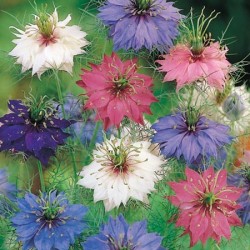



Nigella Persian Jewels is a great flower to fill in borders, beddings. The fennel like foliage gives an additional interest. Beautiful flowers in various shades of blue, mauve, purple, rose and white. Can be used as a cut-flower and the large attractive seedpods can be used as a decoration in the house.
Nigella (Nigella damascena) is known by several different names, like Love in a Mist, Persian Jewels and Devil in a Bush. Whatever name you choose to call it, it’s still a unique and lovely flower. Love in a Mist is the most common name for this annual flower, because the bud looks like a puff of smoke that opens into a blue blossom surrounded by tangled mist of needle-shaped foliage. Hardy in all zones and easy to grow, use these tips for planting and growing your own unique nigella plants. Also check out our Nigella Delft Blue seeds.
Select a location that is in full sun to partial shade. The plants are not too picky about their location as long as they receive 6 hours of direct sunlight each day.
Soil needs to be amended with compost or other organic matter to keep it loose and well-draining.
Nigella has been traditionally grown as a cottage garden flower, but can fit in will any flower garden design since it is one of the few true-blue flowers.
Nigella is one of the few plants that does not do well after transplanting, so it’s best to start with flower seeds sown directly into the planned permanent home of the plant.
This is an annual flower, but the flower seeds will disperse if you leave the flowers on the plants and reproduce after the first planting. Nigella is not aggressive and will reproduce itself without any threat to taking over nearby plants.
Prepare soil by tilling it to the depth of 6-8 inches, then add 2 inches of compost and lightly work it into soil. Sow seeds in prepared outdoor soil one week before the last predicted frost date. Nigella is a cold-dependent germinator, which means the seeds will germinate quickly and more reliably when they are placed in a cold soil. The early spring soil harbors just the right about of coldness to get the seeds off on the right germination foot.
Sow seeds in prepared soil, cover with 1/2 inch of soil and water in well. Keep soil moist during the germination process. New sprouts should appear in 7-14 days. Thin seedlings to 6-9 inches apart.
Nigella is a short-lived plant and one plant will not survive from spring till fall. To keep their unique blooms going strong all summer, plant seeds every two weeks from early spring until mid-summer.
Nigella thrives with minimal water and minor feedings. Only water during time of drought or if the plants are showing signs of stress.
Wait until plants are growing vigorously before adding fertilize. Nigellas do have a voracious appetite and do their best when being fed a steady diet. The easiest way to meet their food goals is to feed them once a week with a water soluble fertilize mixed at one-half the recommended rate. That will meet the food and water needs throughout the growing season.
Remove all the spent blooms from the plants if you want it to keep blooming. However, it the nigella seeds (aka black cumin) is what you want, leave the spent blooms on the plant. When flower heads are left on the plant, they will develop into seeds pods filled with tiny black seeds known as black cumin. If the seeds pods are not harvested, they will eventually fall off and self-seed the plant.
Leave some flower heads on the plants to develop seed pods even if you don’t want it to re-seed and don’t want to harvest the black cumin. The seed pods are so unique and colorful they rival the blooms and are part of the plant’s charm.
Nigella will reach a mature height of 15 inches.
Bloom colors are mainly blue, but newer varieties also produce bloom colors that are pink, purple and white.
The bloom color takes a backseat to the shape of the bloom - fluffy flowers surrounded by ferns-like foliage and fennel-like needles. The seed pods add another textural element to the plant and can be used to create interesting fresh or dried floral arrangements.
The tangle of needle-like foliage resembles fennel fronds and the flavor of the seeds is akin to the flavor of fennel and nutmeg combined and is a popular spice used in Middle Eastern recipes.
To harvest the black cumin, cut plant stem below the seed pods. Bundle several stems together, tie bundle together and place a paper bag over the seed pods. Suspend upside down in a warm, dry place. As the seed pods dry and open the paper bag will catch all the tiny black cumin seeds. Seeds are ready to be planted or used as a spice. Store in an airtight container when using them as a kitchen spice.